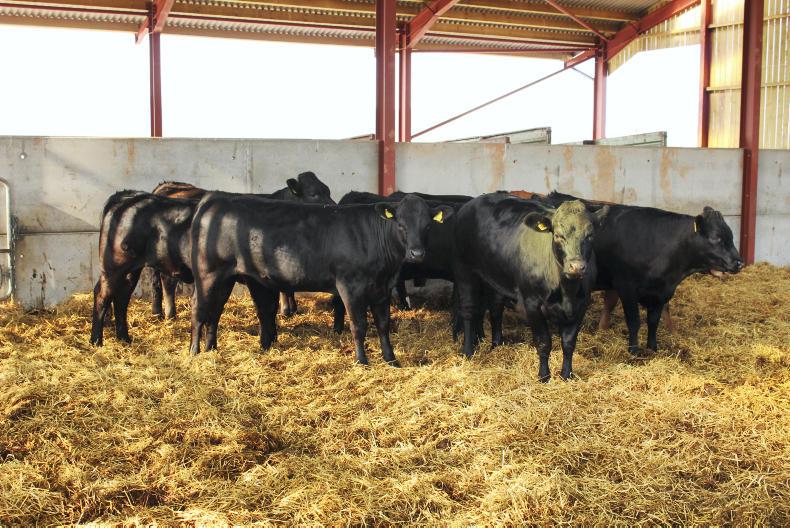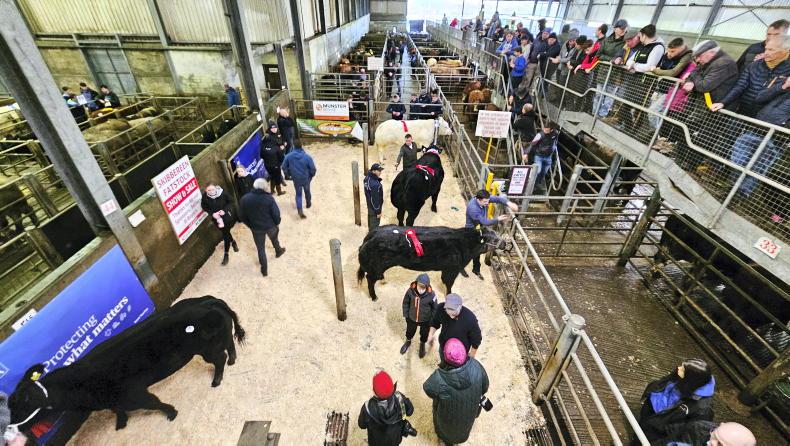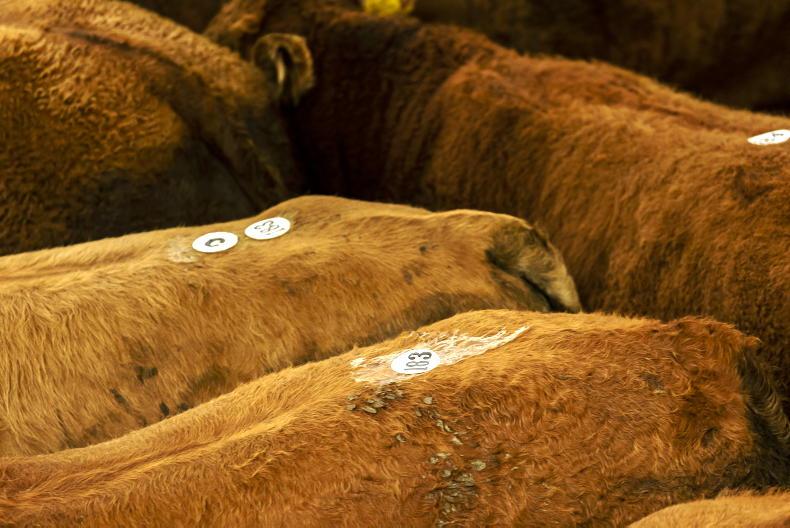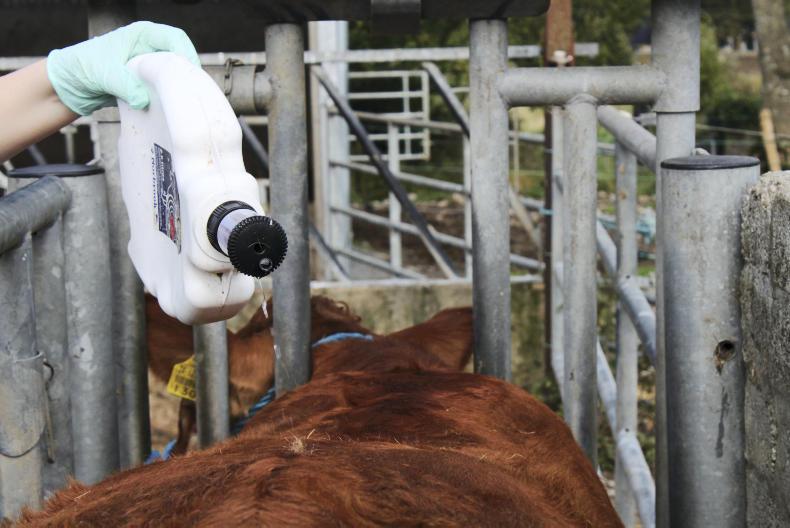It is very much an arable unit in a predominantly arable area. But the Gammie family are changing their farming focus by increasing the area of grass on the farm, at the expense of their arable enterprise. The purpose of this is to allow their suckler herd to expand.
The farm currently carries 80 Limousin and Angus cross suckler cows on a grassland area of 43ha, giving quite a high stocking rate of 2.3 livestock units (LU)/ha.
Within the 80 cows, there are approximately 20 pedigree Limousin cows, operating under the Westpit herd prefix.
All stock bulls are currently Limousin, with Andrew also doing some embryo and AI work on the pedigree cows. Long term, the goal is to grow to 120 suckler cows by increasing the commercial cows and keeping the pedigrees around the same number.
Current business performance
As the business is increasing numbers at such a fast rate, the initial financial benchmarking does not make for good reading.
Currently the cattle enterprise shows a negative gross margin with the enterprise losing £102.80/cow before fixed costs are factored in.
This headline figure does not look good, but it is reflective of any herd going through an expansion phase. For instance, the number of animals sold annually is low, while the number of animals purchased is high, leading to a low output value.
On the variable cost side, the farm shows a high vet bill in the benchmarked year, mainly due to breeding expenses, with embryo transfer being used to help with increasing cow numbers in a short period of time.
The variable costs are also being driven by the herd’s expansion with increased levels of feed required to keep the extra animals.
As the increase in breeding females have yet to produce a calf for sale yet, the variable costs are not being diluted by higher sales output from the extra cattle produced.
However, once the breeding herd stops expanding and the extra cattle sales come through, variable costs will quickly fall.
The challenges
After a few years of poor arable returns, the family decided to increase the livestock numbers and, with this, the herd has grown rapidly in the last couple of years.
With this rapid expansion of the herd, calving pattern has suffered. In the past year, calving lasted for seven months.
In an ideal situation, calving would be tightened to one 12-week period, starting in February. However, with the pedigree cows, autumn calving suits the sale pattern of the pedigree bulls.
To accommodate this, the commercial herd will calve over 12 weeks in the spring and the pedigree herd will calve over 12 weeks in the autumn, starting in September.
Maximising output from the land available
As previously mentioned, Drumforber is very much an arable farm and although the family wants to increase the livestock numbers, they still want to retain a decent level of output from the arable side of the business.
The first part of achieving this will be to improve grassland management.
Two grass fields, totaling 11ha, have been identified to subdivide in year one to run some of the spring cows with their calves and a bull. These two fields will be split in to five equal-sized paddocks and the cattle will be rotationally moved through these paddocks to keep grass digestibility high, driving milk yield and liveweight gain.
The other side of this is minimising the impact of the winter feeding regime on the land available.
With the increase in spring calving cows, a quantity of oat straw will be ammonia treated to feed the dry cows, reducing the amount of silage required over winter. With little of silage being fed to dry cows, high-quality, high-power silage will be made to feed to the stock that need it.
These are the autumn cows, needing to sustain lactation through the winter and the young growing cattle. Some of this silage will come from managing the grazing paddocks in early winter and with all of the above there will be little impact on the area of grass required to keep the herd.
Making best use of high-health status and genetics
Due to the pedigree herd, the Gammies are members of the Hi-Health accredited cattle health scheme.
The herd has a low Johnes risk level at level 1, BVD accredited, IBR monitored and Lepto monitored. When drawing up the farm plan, this was seen as a strength for the business to capitalise on. Part of the farm plan will see breeding heifers being sold either with their first calf at foot, or in-calf, with one of the pedigree bulls being the sire.
The farm already has a weighing system in the handling pens and cattle are weighed regularly. This data will be used by the programme going forward to make sure that everything is on track. By keeping an eye on animal performance through the expansion period, the Gammies will be able to select the best performing animals to keep as replacements for the future, further securing the financial viability of the cattle enterprise on the farm.
Read more
Farm Profit Programme: Andrew and Kathryn Gammie profile
Targeting compact calving in Scotland
It is very much an arable unit in a predominantly arable area. But the Gammie family are changing their farming focus by increasing the area of grass on the farm, at the expense of their arable enterprise. The purpose of this is to allow their suckler herd to expand.
The farm currently carries 80 Limousin and Angus cross suckler cows on a grassland area of 43ha, giving quite a high stocking rate of 2.3 livestock units (LU)/ha.
Within the 80 cows, there are approximately 20 pedigree Limousin cows, operating under the Westpit herd prefix.
All stock bulls are currently Limousin, with Andrew also doing some embryo and AI work on the pedigree cows. Long term, the goal is to grow to 120 suckler cows by increasing the commercial cows and keeping the pedigrees around the same number.
Current business performance
As the business is increasing numbers at such a fast rate, the initial financial benchmarking does not make for good reading.
Currently the cattle enterprise shows a negative gross margin with the enterprise losing £102.80/cow before fixed costs are factored in.
This headline figure does not look good, but it is reflective of any herd going through an expansion phase. For instance, the number of animals sold annually is low, while the number of animals purchased is high, leading to a low output value.
On the variable cost side, the farm shows a high vet bill in the benchmarked year, mainly due to breeding expenses, with embryo transfer being used to help with increasing cow numbers in a short period of time.
The variable costs are also being driven by the herd’s expansion with increased levels of feed required to keep the extra animals.
As the increase in breeding females have yet to produce a calf for sale yet, the variable costs are not being diluted by higher sales output from the extra cattle produced.
However, once the breeding herd stops expanding and the extra cattle sales come through, variable costs will quickly fall.
The challenges
After a few years of poor arable returns, the family decided to increase the livestock numbers and, with this, the herd has grown rapidly in the last couple of years.
With this rapid expansion of the herd, calving pattern has suffered. In the past year, calving lasted for seven months.
In an ideal situation, calving would be tightened to one 12-week period, starting in February. However, with the pedigree cows, autumn calving suits the sale pattern of the pedigree bulls.
To accommodate this, the commercial herd will calve over 12 weeks in the spring and the pedigree herd will calve over 12 weeks in the autumn, starting in September.
Maximising output from the land available
As previously mentioned, Drumforber is very much an arable farm and although the family wants to increase the livestock numbers, they still want to retain a decent level of output from the arable side of the business.
The first part of achieving this will be to improve grassland management.
Two grass fields, totaling 11ha, have been identified to subdivide in year one to run some of the spring cows with their calves and a bull. These two fields will be split in to five equal-sized paddocks and the cattle will be rotationally moved through these paddocks to keep grass digestibility high, driving milk yield and liveweight gain.
The other side of this is minimising the impact of the winter feeding regime on the land available.
With the increase in spring calving cows, a quantity of oat straw will be ammonia treated to feed the dry cows, reducing the amount of silage required over winter. With little of silage being fed to dry cows, high-quality, high-power silage will be made to feed to the stock that need it.
These are the autumn cows, needing to sustain lactation through the winter and the young growing cattle. Some of this silage will come from managing the grazing paddocks in early winter and with all of the above there will be little impact on the area of grass required to keep the herd.
Making best use of high-health status and genetics
Due to the pedigree herd, the Gammies are members of the Hi-Health accredited cattle health scheme.
The herd has a low Johnes risk level at level 1, BVD accredited, IBR monitored and Lepto monitored. When drawing up the farm plan, this was seen as a strength for the business to capitalise on. Part of the farm plan will see breeding heifers being sold either with their first calf at foot, or in-calf, with one of the pedigree bulls being the sire.
The farm already has a weighing system in the handling pens and cattle are weighed regularly. This data will be used by the programme going forward to make sure that everything is on track. By keeping an eye on animal performance through the expansion period, the Gammies will be able to select the best performing animals to keep as replacements for the future, further securing the financial viability of the cattle enterprise on the farm.
Read more
Farm Profit Programme: Andrew and Kathryn Gammie profile
Targeting compact calving in Scotland









SHARING OPTIONS